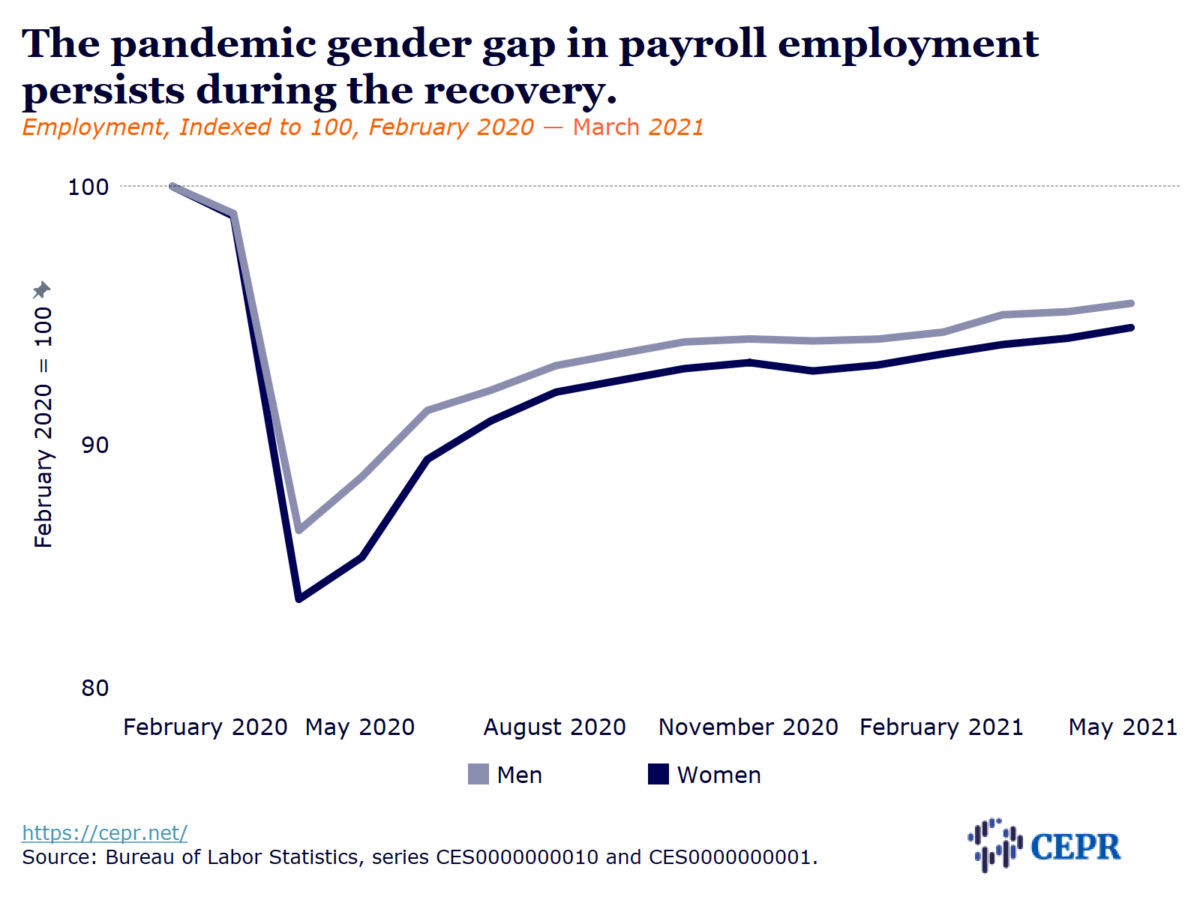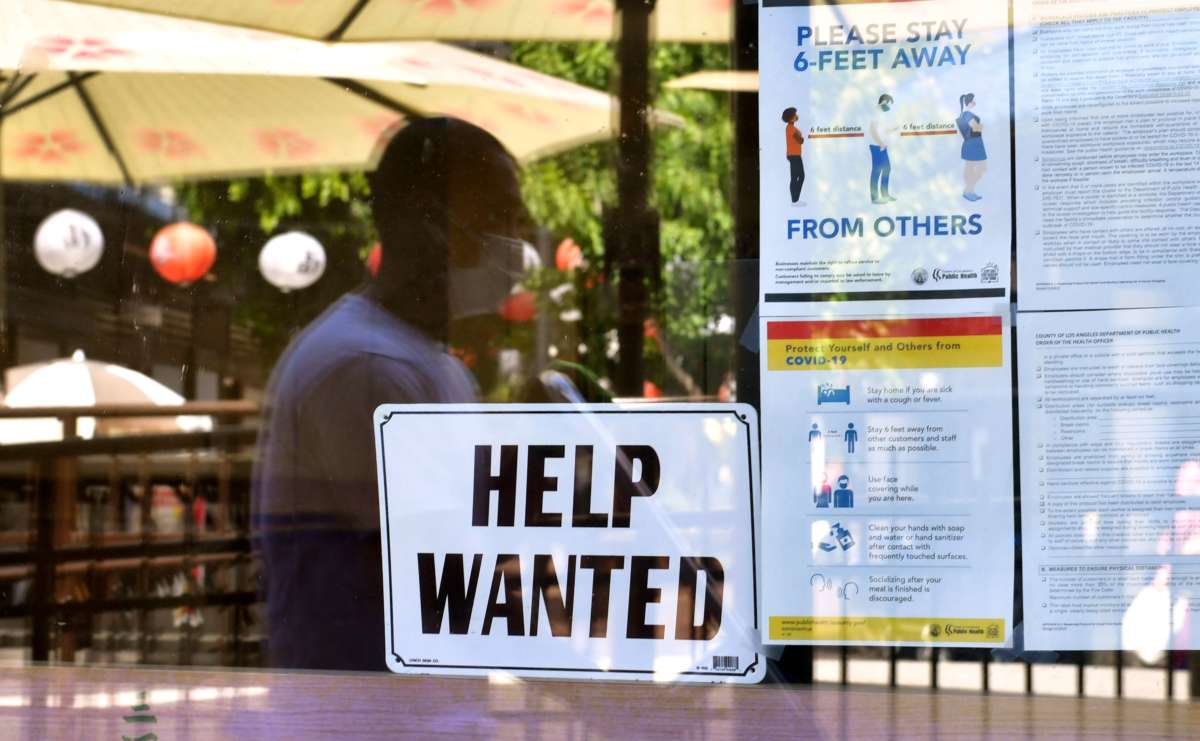The May employment report was somewhat weaker than had generally been expected, with the economy adding 559,000 jobs. On the household side, the unemployment rate fell by 0.3 percentage points to 5.8 percent. While this is still high by any reasonable measure, it is worth noting that the unemployment rate did not get this low following the Great Recession until October of 2014.

The employment-to-population ratio (EPOP) edged up to 58.0 percent, which is 3.1 percentage points below the pre-pandemic level. By this measure, the gender differences in the hit from the pandemic have largely disappeared, the women’s EPOP for May was 53.1 percent, down 2.3 percentage points from its average in 2019. For men the May EPOP was 63.4 percent, down 3.2 percentage points from its year-round average of 66.6 percent in 2019. However, in payroll employment, women’s share was 49.8 percent in May, compared with 50.0 percent before the pandemic.
(It is important to note that states that ended unemployment insurance supplements would not likely affect the May data. The termination did not take effect until June, the reference point for the survey is May 12th.)
Private Sector Performance Was Strong, as Governments Lag in Rehiring Workers
The private sector accounted for 492,000 of the May job growth, as state and local governments added back just 78,000 workers in the month (the federal government lost 11,000 jobs). State and local employment is still 1,191,000 below its pre-pandemic level, with the vast majority of this gap in education. With the end of the regular school year this month, pandemic closings will be less of an issue in June, but presumably all schools will be open again for in-class instruction in the fall.
The private sector is down 6,462,000 jobs since February 2020. At the May rate of job growth, it will take just over 13 months to make up the gap.
Restaurants Biggest Source of Job Gap
In absolute numbers, restaurants make up the largest chunk of this shortfall, with employment still down 1,480,000 from the pre-pandemic level, after adding 186,000 jobs in May. While many employers claim that they aren’t hiring because they can’t find workers, it’s not clear how much impact this shortage is having. Wages have been rising rapidly for nonsupervisory workers in the industry, a 22.2 percent annual rate comparing the average of the last three months (March, April, and May) with the prior three months (December, January, and February), but the average workweek actually fell slightly in May, from 25.3 hours to 25.1 hours.
On the plus side, the index of aggregate hours in the industry is still 12.4 percent below its pre-recession level. With restaurant sales likely passing their pre-pandemic level in May, this implies a huge gain in productivity. This is true more generally, as the overall index of aggregate hours for May stood 3.6 percent below the February level, even as output is virtually certain to pass pre-pandemic levels in the quarter.
Big Job Gains in Most Troubled Sectors
The health care sector, which is down 508,000 jobs from before the pandemic, added 22,500 jobs in May. Nursing care facilities, which are down 202,000 jobs, added back just 1,000 jobs in May, after losing 17,700 in April. This is a sector where low and poor working conditions may make it difficult to attract workers.
Hotels, which are down 526,000 jobs, added 34,600 jobs in May. The other services category, which includes sectors such as hair salons and dry cleaners and is down 353,000 jobs, added 10,000 jobs in May. The retail sector, which is down 411,000 jobs, actually lost 5,800 jobs in May. This is another sector where it seems there have been strong productivity gains. The motion picture sector, which is among the worst hit in percentage terms, down 157,000 jobs or 35.6 percent, added 13,900 jobs in May.
Construction and Manufacturing Coping With Shortages
Construction lost 20,000 jobs in May after losing 5,000 in April. This is likely due to temporary shortages of building material, most importantly lumber. Manufacturing added 23,000 jobs, reversing most of the job loss in April, as it seems auto manufacturers are finding ways to deal with the semiconductor shortage.
Recovery Continues to Benefit More Educated Workers
The unemployment rate for college grads fell 0.3 percentage points to 3.2 percent in May. It is down 0.8 percentage points from the start of the year. By contrast, the unemployment rate for high school grads dropped just 0.1 percentage points to 6.8 percent. It has fallen 0.3 percentage points since January.
Black Teen Unemployment Hits a Record Low
The unemployment rate for Black teens fell to 12.1 percent in May, by far the lowest level on record. These data are highly erratic, so we may see a big jump in future months, but it does seem to indicate they are doing relatively well in the current labor market.
The overall Black and Hispanic unemployment both dropped 0.6 percentage points in May, to 9.1 percent and 7.3 percent, respectively. The unemployment rate for Asian Americans is still somewhat higher than for whites, 5.5 percent compared to 5.1 percent for whites. It was slightly lower pre-recession.
Long-Term Unemployment Falls and Quit Rate Rises Modestly
The share of long-term unemployed (more than 26 weeks) fell back from 43.0 percent to 40.9 percent in May. This is still very high; a more normal rate would be in the teens. The percent of unemployment due to voluntary quits edges up to just 8.4 percent. It was over 14.0 percent pre-pandemic, indicating workers still don’t feel great about their labor market prospects.
Jump in Self-Employed
There has been a big jump in the number of self-employed workers in the last three months, with the three-month average of 9,843,000 more than 300,000 above the year-round average for 2019. These data are erratic, but it is possible that many people are finding ways to work from home for themselves instead of returning to the workplace.
Generally Solid Report
The jobs numbers were somewhat weaker than expected again in May, but much of this continues to be due to schools not reopening. In terms of employers having trouble hiring workers, there is some evidence, most notably the relatively rapid wage growth for production workers, (i.e., 4.5 percent annual rate, comparing the last three months with the prior three months.) On the other hand, the small drop in hours in average weekly hours is not consistent with a shortage.
The plus side of weaker-than-expected job growth is that it means productivity growth is very strong. With output now passing pre-pandemic levels, but employment still far lower, this means we are getting much more output per hour. Strong productivity growth should eliminate any fears of inflation.
Join us in defending the truth before it’s too late
The future of independent journalism is uncertain, and the consequences of losing it are too grave to ignore. To ensure Truthout remains safe, strong, and free, we need to raise $50,000 in the next 9 days. Every dollar raised goes directly toward the costs of producing news you can trust.
Please give what you can — because by supporting us with a tax-deductible donation, you’re not just preserving a source of news, you’re helping to safeguard what’s left of our democracy.
